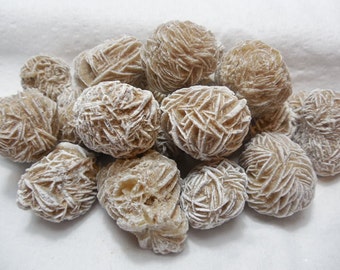Apophyllite
Physical Characteristics: Apophyllite refers to a specific group of phyllosilicates (sheet silicates formed in parallel layers). All phyllosilicates are hydrated minerals, Apophyllite being a variety which contains water in its chemical structure.
There are technically three varieties of Apophyllite, each varying slightly in chemical composition: Fluorapophyllite (white, colorless, yellow, green, or violet specimens), Hydroxyapophyllite (white or colorless specimens), and Natroapophyllite (brown, yellow, or colorless specimens). Heating the crystal causes water loss, which in turn can cause it to flake apart.
In Nature: This crystal is typically found in vesicles of Basalt or other volcanic rocks.
Chemical Composition: (K, Na)Ca4Si8O20(F, OH)•8H2O
Mohs Scale Hardness: 4.5-5 (medium)
Can be Found: India, Germany, Canada, Norway, Scotland, Ireland, Brazil, Japan, United States
Healing Properties*: Placed on the eyelids, Apophyllite is thought to reduce eye strain. It relieves anxiety and stress, and can also reduce allergy symptoms. Apophyllite is a common tool in Reiki healing.
Magickal Properties: Apophyllite is perhaps best-known for being a high-vibration crystal. The stone's energy is uplifting, and is often used for removing energy blockages and for helping its bearer grow spiritually. It opens the Third Eye, and in so doing furthers psychic development; use it to enhance clairvoyance, for dream work, for astral travel/projection, meditation, and similar exercises. The stone is ideal for scrying, in part because many specimens contain prismatic defects that help the mind relax. It also opens the Crown Chakra, making it easier to contact spiritual guides, angels, and other higher powers.
The water content of the stone improves its energy-conducting capacity, which may be further enhanced by the shape of the crystal (e.g. a pyramidal form). To cleanse and empower a room with Apophyllite, create a crystal grid by placing one stone in each corner of the room and another in the room's center.
Generally speaking, it is inadvisable to cleanse hydrated crystals with water. As heat can damage the stone, it is likewise inadvisable to cleanse Apophyllite in direct sunlight.
Chakra Association: Third Eye (Sixth) and Crown (Seventh) chakras
Chakra Association: Third Eye (Sixth) and Crown (Seventh) chakras
Element: Air
Energy: Receptive
Planetary Association: Mercury
*Magickal healing should never take the place of seeing a doctor and following any recommended prescriptions, actions, or other advice. Magick works best in tandem with physical efforts, anyway, so don't skimp on those check-ups!
Energy: Receptive
Planetary Association: Mercury
*Magickal healing should never take the place of seeing a doctor and following any recommended prescriptions, actions, or other advice. Magick works best in tandem with physical efforts, anyway, so don't skimp on those check-ups!















.JPG)
.JPG)







